OBKA Tutors Blog #10 – 2 Metre mentoring
or Conducting A First Inspection
Friends Henrietta and John had acquired a Nuc. Of bees, A Hive, and (before lockdown) my services as a Mentor.
With the relaxation in lockdown, and maintaining a strict 2 m separation, a Mentored hive inspection took place on Sunday 17th May. I took a camera with reasonable telephoto, and was able to take photos to help with this article.
Henrietta & John’s Hive is beyond a pond – a great source of water for thirsty bees, and a good 2 metre wide barrier!
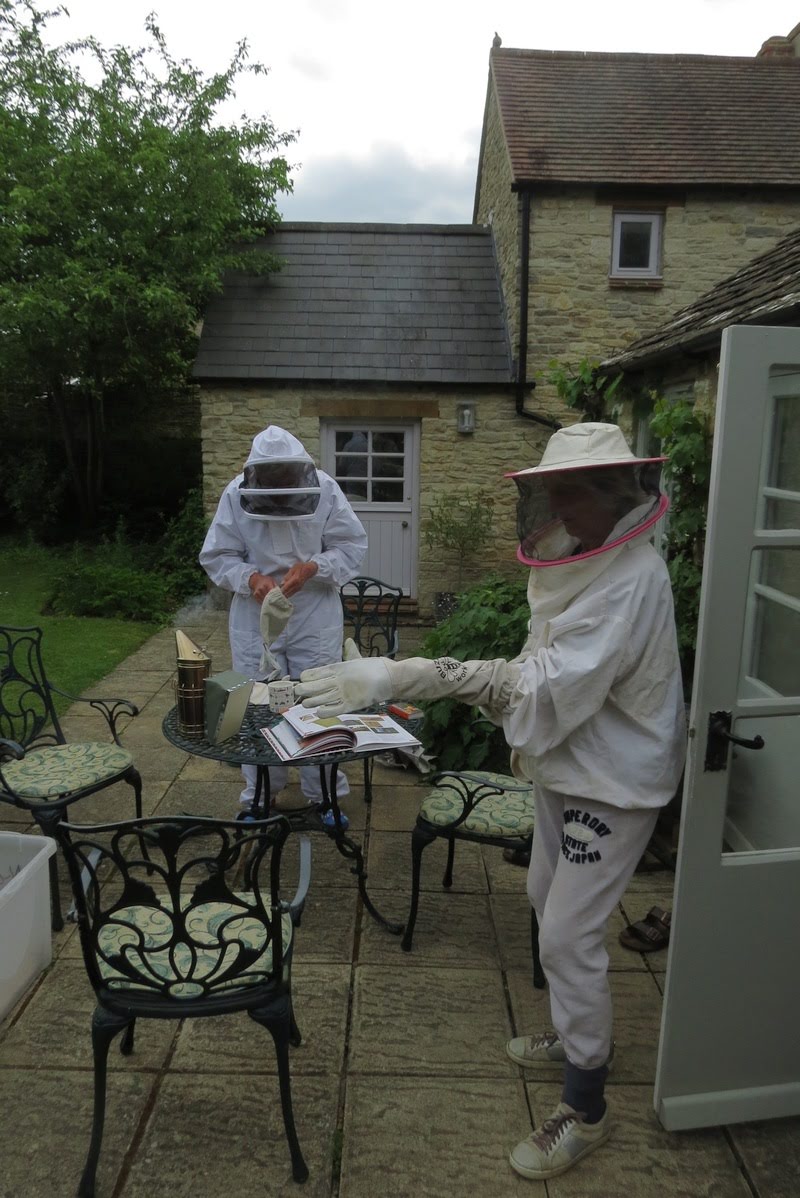
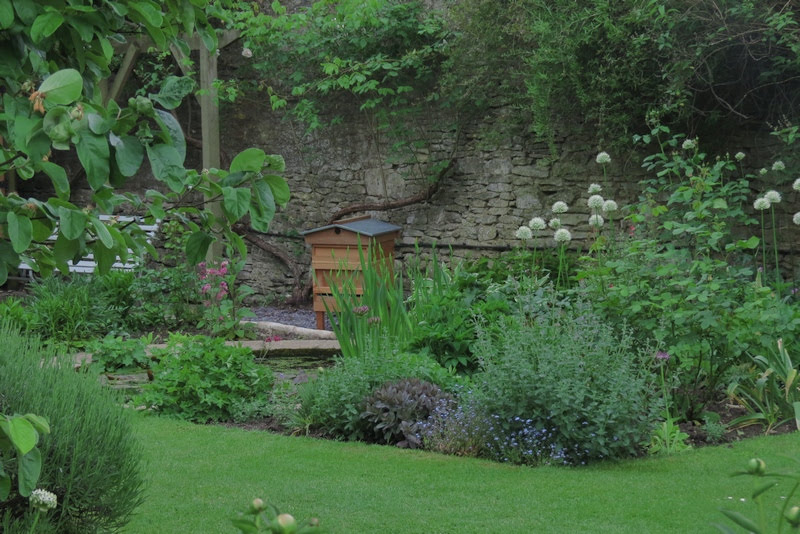
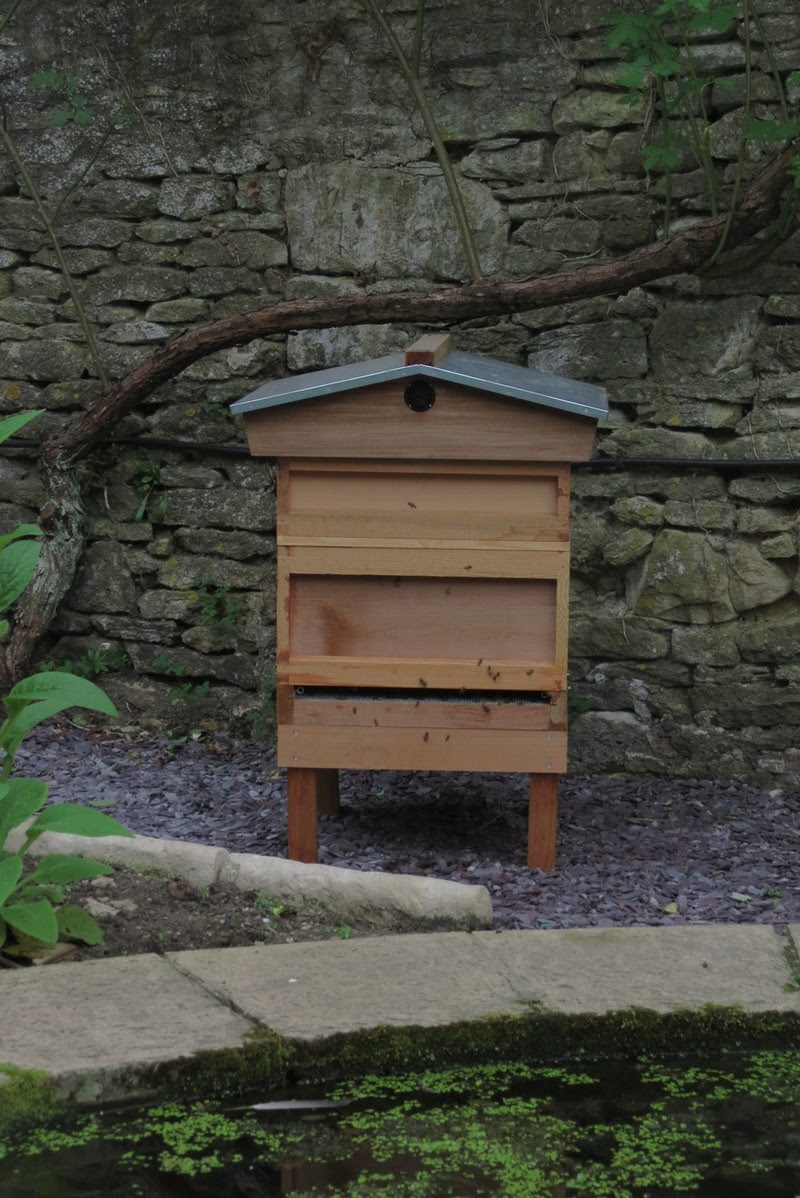
John got the smoker going – using grass pellets, which is fine – anything dry and burnable works as smoker fuel – my favourite is hessian (sacking, burlap to our American friends). Feel free to experiment – corrugated cardboard, rotting wood, hay, straw, wood shavings.
Supplement with sprigs from Rosemary if you don’t want to come home smelling like a bonfire!
Lighting the smoker is a bit of an art, and keeping it alight surprisingly difficult … after 29 years beekeeping, they still go out on me! Always have your lighter in your pocket!
After smoking the bees, Henrietta took the roof off and put it where no one was going to fall over it!
Its good to smoke the bees and wait a couple of minutes after, so that they have time to respond to the smoke.
The generally used explanation for the effectiveness of smoke is that it stimulates their flight or fight response, naturally bees would live in woodland, and the smoke simulates a forest fire; they can not fight, so they prepare to flee, filling their stomachs with honey; this makes them more docile, and also less able to sting as they can not bend their abdomens. The smoke also interferes with their ability to sense the alarm pheromone, which may be a more scientific explanation. Whatever, it works!
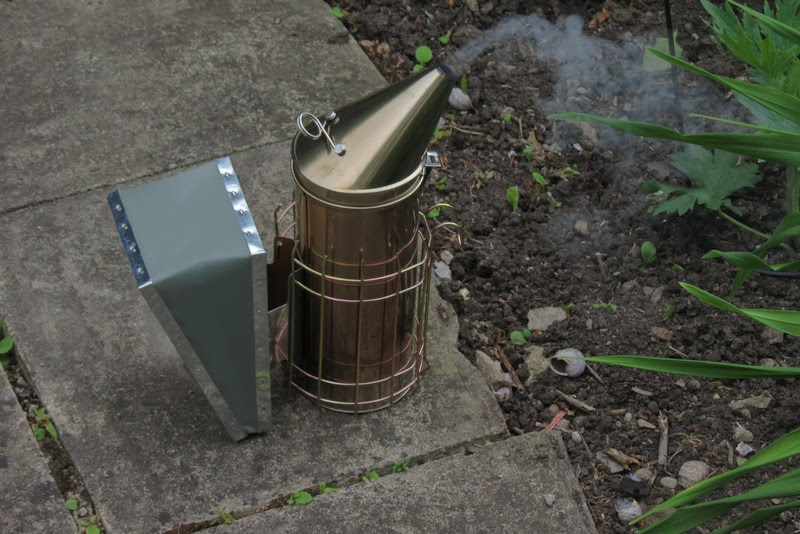
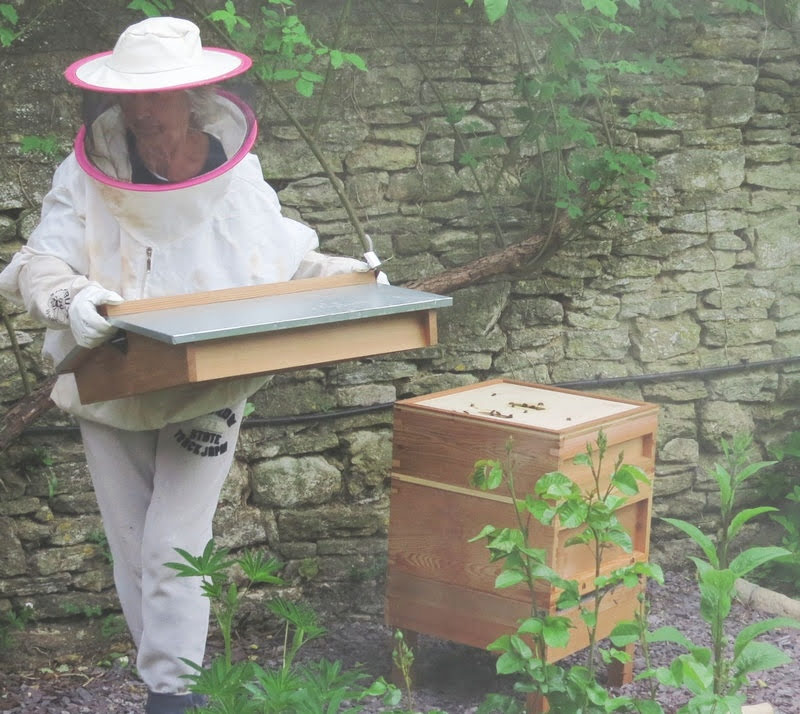


Off with the Crown Board – often we’d leave inspecting the supers till last, but we wanted to find out what was going on and so have a good look now!
The super was only put on the hive a week ago, so we were delighted to find that most of the frames had been drawn out into honey comb, and there was nectar, and even some sealed honey, on the frames.
In order to “encourage” the bees, we moved a couple of undrawn frames to the centre, where they’ll draw them out, and the full frames to the edge – they’ll finish them off over the next 10 weeks.
Question – This hive is a “National” with a single brood box and a single super; what are the alternative hive types, and brood box configuration.
Good use of the hive tool, to lever up frames for inspection.
The frames here are fitted into “castellation” type runners, which hold them in position at a precise distance apart, so that the all important bee space is maintained. There are other ways of spacing the frames.



We took one of the super frames out, just to see what was going on; the frame went in with undrawn comb 7 days ago, so in 7 days the colony have
- drawn the frames out and
- filled with nectar (the shiny liquid you can see in each cell is nectar – honey in progress!).
And they've been working on the other frames in the super too!
Great work Girls!!
We moved unused frames to the centre to encourage the bees to start work on them, and put the “filling” ones in their place – there’s about 10 weeks till the end of July when the harvest comes off and hopefully the bees will completely fill this super, and another in that time! Perhaps 50 Lb (25Kg) of lovely, local honey …. what will it taste like? What colour will it be?
Question … why is honey different colours and flavours?
When we took the super off, we found wild comb on the queen excluder; this is slightly annoying (making wax requires a lot of energy on the part of the bees) and will be in the way.
We cleaned this off – wax is a valuable bye product – think candles, think furniture polish, think lip balm or hand cream.
With the queen excluder removed, we had access to the brood box; the real interest.



The history of this colony is that it came as a 5 frame nuc 5 weeks ago, and you can see that Henrietta and John put the 5 frames in the centre of the hive (the darker ones with the coloured ends) and then put new frames on each side (so from left to right you can see the dark brown “dummy board”, 3 new frames, 5 older frames, and then 3 more new frames).
QUESTION: you can see the old frames are marked with paint; why do you think that could be? What colours are used here, and why?
Henrietta took the “dummy board” out and again some wild comb had been formed on that – we cut that off and set it aside with the other wax.
This makes a bit of space so you can remove the other frames without rolling bees against each other.
Question: why did the bees make the wild or “brace” comb?
This was frame 3, and the bees have been working hard. In 5 weeks, they've drawn this comb out. Filled it with brood, nectar (uncapped) and honey (capped); you can see that the colour of the (wax) cappings is different for honey and brood.
Henrietta shook the bees off so we could see the frame better, and here it is again. You can see a bit more wild comb at the bottom of the frame too – we left this.
The lines in the brood area are where the wire in the foundation runs; the queen has chosen not to lay eggs in those cells. The wire will not be completely embedded, so the queen will reject the cell when checking it before laying an egg into it.

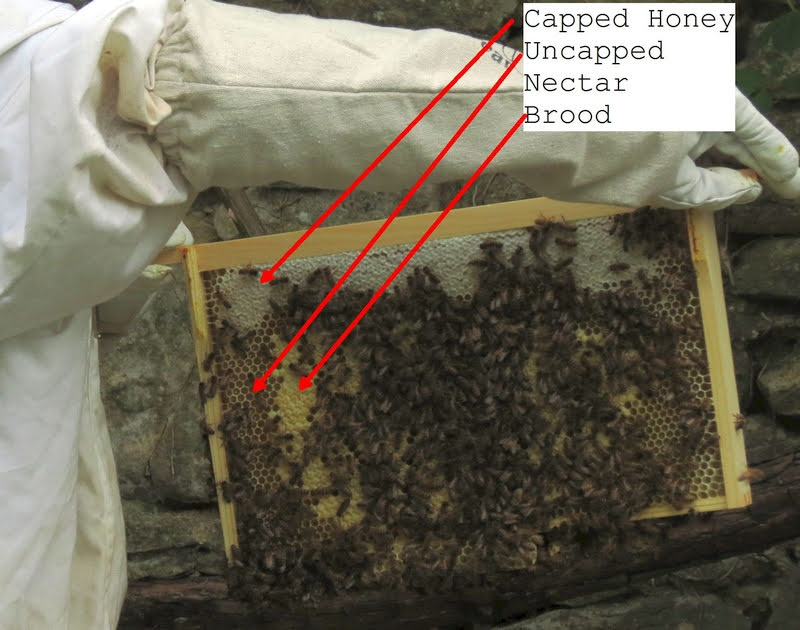

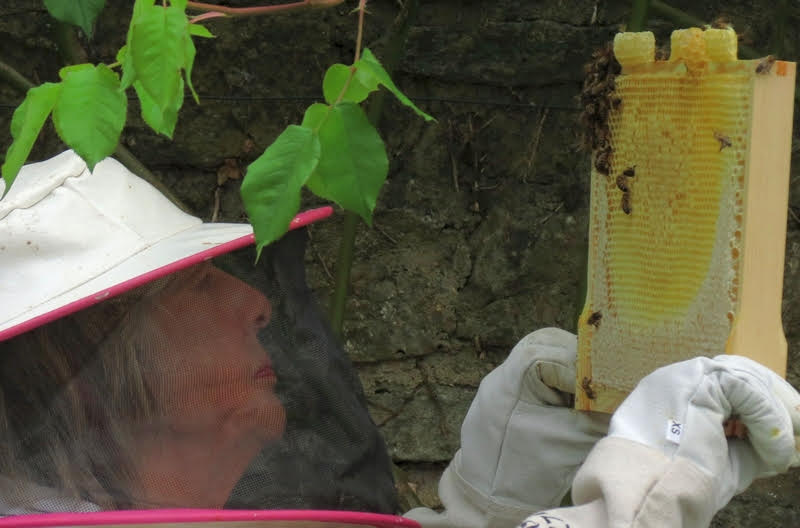

Henrietta shook the bees off this frame and is looking for eggs – which are a sure sign that the queen has been there in the past few days and generally, if you find eggs, you can be sure that the colony is queen right without needing to find the queen.
Eggs are very tiny (about the size of the eye of a needle) so hard to see – I have to be wearing my reading glasses, and need good light! The mesh of the Veil does not help either!
You can see that the brood under the bottom bar on this frame is different from the brood above, This is “Drone” brood. - drones of course are the male bees, and they are a bit bigger than the workers, so need bigger cells to develop in. When capped, they have “domed” cappings, and are very distinctive.
Question: what do drones do? And what happens to them in the autumn? Why is Drone Brood useful?
We wanted to find the Queen – of course – she had been marked and clipped, and so was relatively easy to find.
Question – why would you mark, and clip the queen??
Is it significant that the queen is marked with green paint?
And this is why the queen is hard to find; she’s right in the centre here, but other bees are on top of her! You can just see the green mark, but what is usefully shown is that her abdomen (back end) is much longer and differently marked than the other bees. This is what I look for when looking for an unmarked queen.



Since we’d not been able to find eggs, and wanted to, we tried using a small torch to help find them – a magnifying glass would have been useful too!
We went right through the “brood” are of the hive, and the last frame was this one; there’s no brood here, but the bees are very organised, and are using it to store pollen, nectar and honey, very close to the brood nest where they’ll need it.
Pollen comes in many different colours, distinctive to the flowers the bees have collected it from. Here’s a detail so you can more easily see the different pollen colours.
Question: Honey comb is made from bee’s wax – but where does the bee’s wax come from?




Job done, and the hive is carefully put together. This roof is pitched so its put on this way round so the rain is shed to the sides, not on the entrance and “alighting board”.


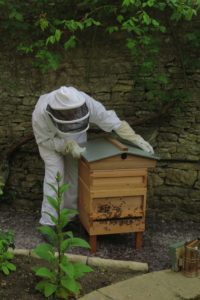
Inspection over, a chat …. lots of questions!
- What about Varroa, and varroa treatment. And other disease
- What can you do with the wax- why is wax valuable and not to be wasted
- How do you tell the difference between the queen, drones and workers
- When do we get the honey harvest (and why)
- When do we put the second super on?
So we ‘ll try to answer those in future blogs, and if you've other questions, then pose them in the OBKA Beekeeping Q&A section and we’ll do our best to answer!
This is the Mentor’s side of the story, Henrietta will write it up from the “Victim’s” point of view, and it will be published in Kidlington News Online https://kidlingtonnews.org/ !
Andy Pedley